
Paccha (ritual watering device),1440–1540, ceramic, 14 9/16 x 5 7/8 x 4 3/4 inches (Michael C. Carlos Museum)
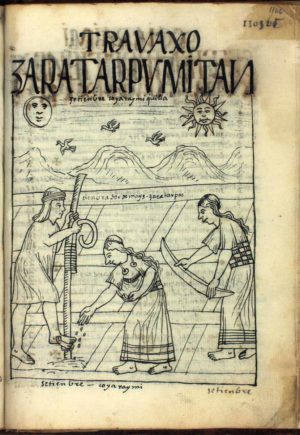
“September: Cycle of sowing maize; Quya Raymi Killa, month of the feast of the queen, or quya” Felipe Guaman Poma de Ayala, The First New Chronicle and Good Government (or El primer nueva corónica y buen gobierno), c. 1615 (The Royal Danish Library, Copenhagen)
Felipe Guaman Poma de Ayala, in his massive colonial treatise The First New Chronicle and Good Government (or El primer nueva corónica y buen gobierno), dedicated an entire chapter to the months of the year and the traditional Inka agricultural activities associated with them. Planting, tending, and harvesting plants are all depicted, but one aspect of Inka farming prior to the arrival of the Spaniards is missing — the ceremonial use of a ritual watering device, known in Quechua as a paccha (POCK-cha).
Because Guaman Poma was interested in showing the Spanish king that the natives of the Andes, and especially the Inka, had become good Christians, he may have left out the paccha and its ritual use as an unnecessary reminder of pre-Christian traditions that the Spaniards considered idolatry.
Iconography of maize
While pacchas come in several styles and different imagery (in part due to the extensive reach of the Inka empire and local variations), the one seen above incorporates a sophisticated symbolism in its component parts that signals its purpose as a ritual device intended to promote agricultural fertility. Its three parts are composed of a taclla, or foot plow, an urpu or storage vessel, and an ear of corn, more properly called maize (Zea mays). When used in a ritual at the beginning of the planting season, the paccha symbolically encompassed the entire cycle of maize farming and use in the Inka world.
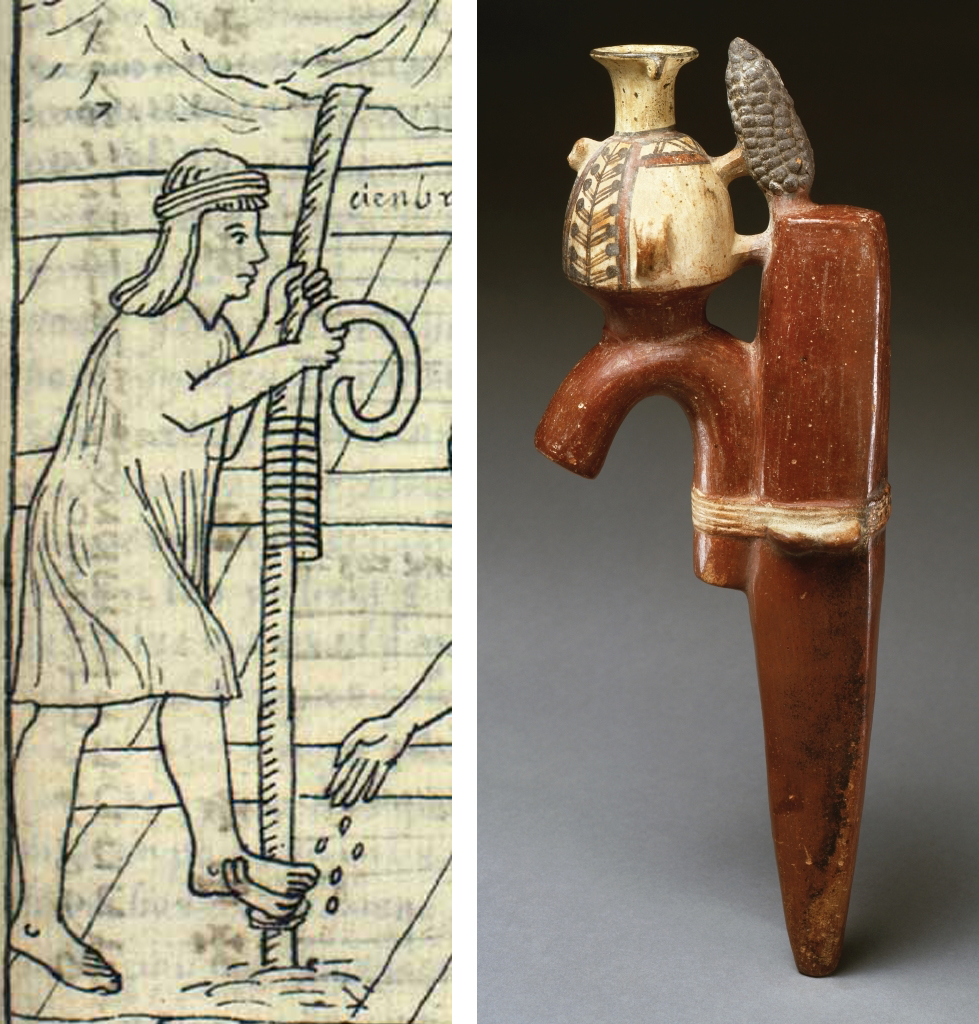
Left: “September: Cycle of sowing maize; Quya Raymi Killa, month of the feast of the queen, or quya” Felipe Guaman Poma de Ayala, The First New Chronicle and Good Government (or El primer nueva corónica y buen gobierno), c. 1615 (The Royal Danish Library, Copenhagen); Right: Paccha (ritual watering device), 1440–1540, ceramic, 14 9/16 x 5 7/8 x 4 3/4 inches (Michael C. Carlos Museum)
The taclla that forms the long portion of the paccha is a truncated version of the real farming implement. As we can see in a detail from Guaman Poma’s illustration, the portion in the paccha is the lower part, the part that is pushed into the soil to create a hole for seeds to be planted, combined with the curved handle from the upper portion. It represents the beginning of the agricultural year, when the soil is prepared and then planted. The form of the taclla is smooth and simple, an idealized form of the two pieces of wood bound tightly with string.
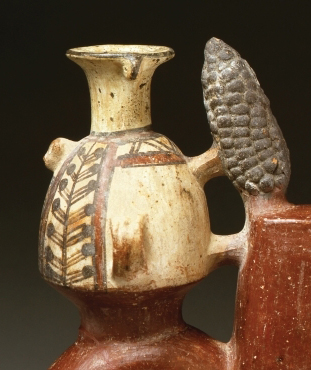
Paccha (ritual watering device), detail of urpu and maize, 1440–1540, ceramic, 14 9/16 x 5 7/8 x 4 3/4 inches (Michael C. Carlos Museum)
At the top of the taclla is a small ear of maize, painted with a black slip. It is highly naturalistic, and that is because it was made by taking an actual ear of maize and pressing two soft pieces of clay around it to form a mold. Once dry, the mold was used to create the ceramic replica.
The maize cob represents the growing and harvest portion of the agricultural year, the production of this symbolically and functionally important crop. Inka art runs the gamut from highly naturalistic to completely nonrepresentational, and it is perhaps a testament to maize’s importance that the cob on the paccha was produced with such exactitude. However, not all pacchas treated maize so naturalistically. A pair of similar pacchas (seen below) show a less careful construction, especially in the depiction of the maize cob. Rather than being molded from a real cob, the form was sculpted, giving it a more textured appearance.
The urpu perched next to the maize cob is a form of storage vessel that was produced in large quantities throughout the Inka empire. They are characterized by two handles on the lower sides of the vessel and a nub or small projection near the neck, which allowed a rope to be passed through the handles and looped over the nub so that it could be carried on a person’s back or as part of a llama’s pack. The pointed bottom of the vessel allowed it to be pushed into the earth for stability when being stored. Urpus had several uses, but principal among them was storage of maize and brewing of chicha, a type of beer made from maize that was an integral part of Inka social rituals. The urpu represents the use of the products of the agricultural cycle, especially the production of chicha and its use in feasting and religious rituals.
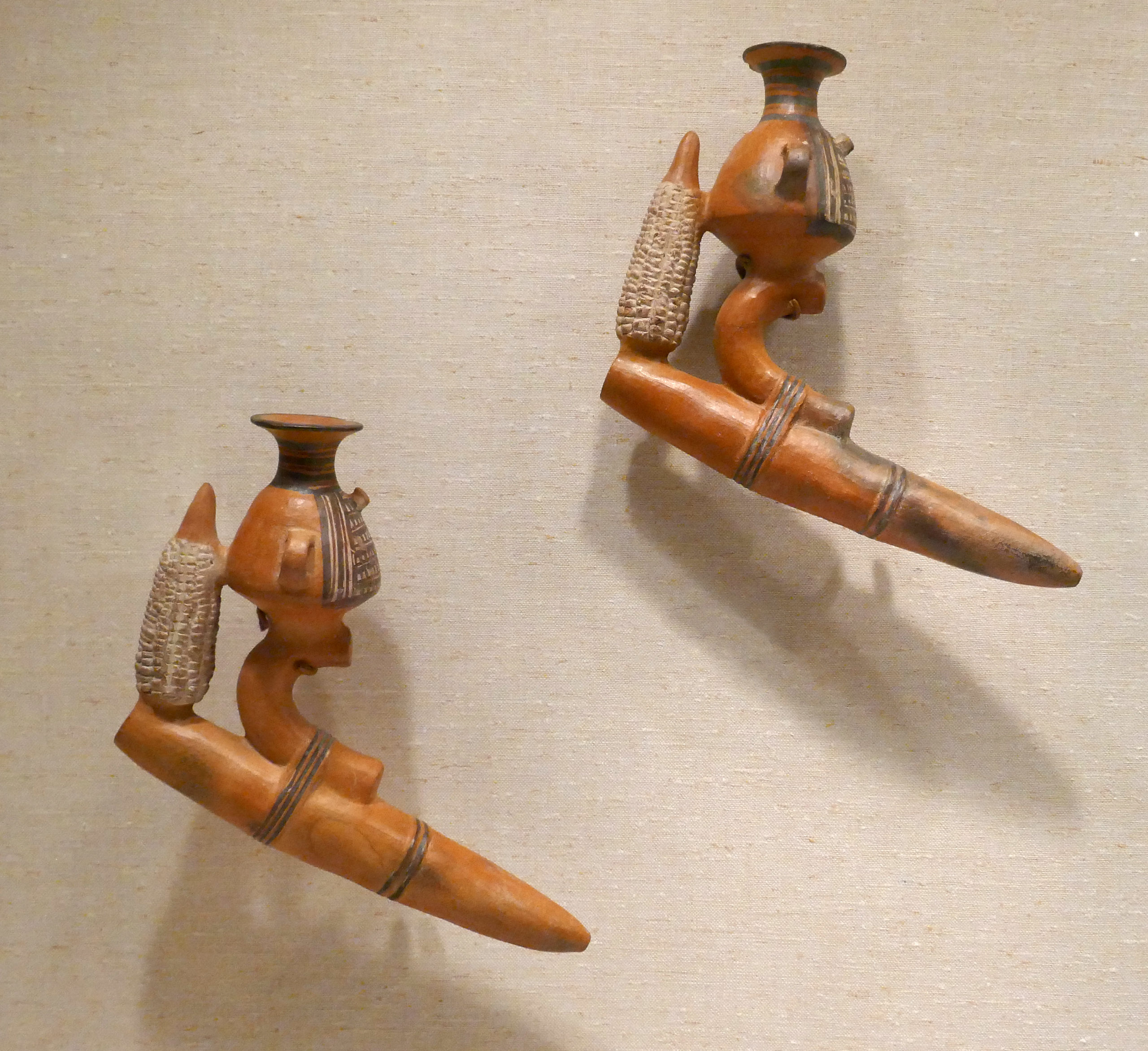
A pair of pacchas with taclla, urpu, and maize imagery (The Metropolitan Museum of Art; photo: Dr. Lisa Trever, CC BY-NC-SA 4.0)
Feeding the earth, enacting obligation
The ceremony that the paccha was used in “fed” chicha back to the earth. The point of the taclla was pushed into the prepared field (you can see some damage at the base of the paccha, probably indicating it was used for many rituals over time). Chicha was mixed with some soil, and poured through the paccha into the ground. This action imbued the soil for the coming agricultural year with some of the success of the last one, “fed” the earth, and made it ritually fertile and ready to continue the agricultural cycle. By making the paccha a microcosm of that cycle, it added further spiritual power to the ritual of watering the earth with chicha.
Extensive scientific analysis by Dr. Rebecca Stone and other specialists at Emory University has been able to pinpoint considerable specific information about this paccha. Residue from the ritual use of the device left behind not just traces of chicha, but also sand particles that can be identified as from the Chancay river valley of coastal Peru, an area that was conquered by the Inka. In addition, the level of detail in the maize cob made it, too, identifiable. It is a strain that was grown in the Chancay valley, having been developed in the Cusco region and brought to the coast with the Inka conquest.
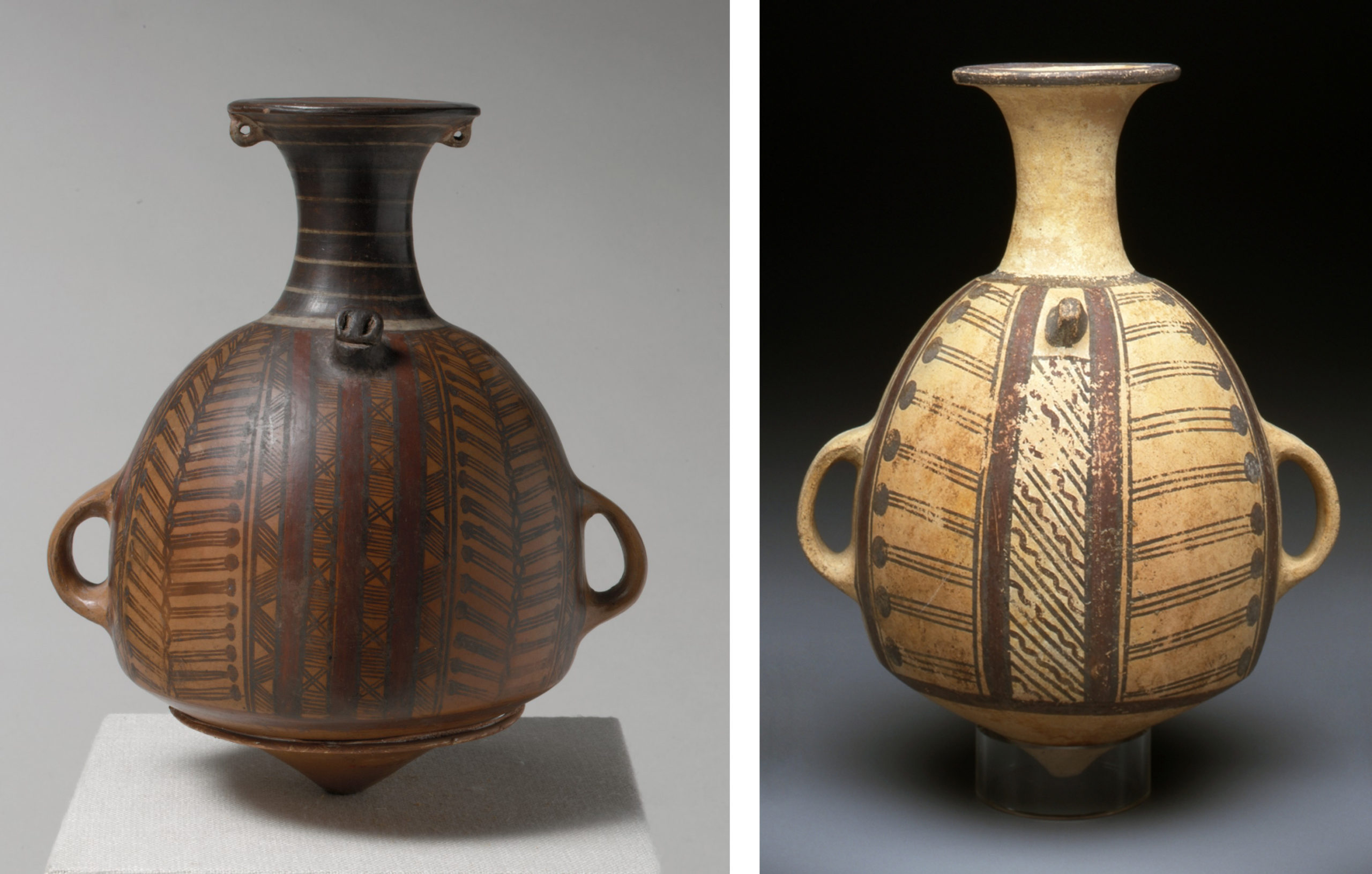
Left: Cusco-style urpu, ceramic, 15th–early 16th century, 8 5/8 x 7 3/8 x inches (The Metropolitan Museum of Art); Right: Chancay colonial Inka urpu, 1440–1540, ceramic, 9 ¾ x 6 ½ inches (Michael C. Carlos Museum)
The urpu on the paccha is also something that has Inka-Chancay connections: it is a Chancay-style version of the traditional Inka form. The urpus seen above are similar in form, but have different painting styles. The one on the left is from the Cusco region, and is painted with multiple colors on an orangey background. The one on the right was made in the Chancay valley during the Inka occupation, and uses a Chancay color palette of brown-black colors over a light cream. They both feature the same abstract motif featuring a long upright line, with smaller forms consisting of three parallel lines ending in a circle projecting from it. This is a common motif, and has been interpreted as an abstraction of a maize plant by some scholars, although others speculate that it is meant to represent a khipu (an information-encoding device made from knotted string).
The ritual this paccha was made for would have been enacted in fields the Inka owned in the Chancay lands they had conquered. It would have been the first “drink” of the agricultural year that the dry soil had on the arid coast, a gift from the Inka that the earth would be obligated to pay back in maize. Soon after the soil had been planted, the more commonplace watering via irrigation would commence, but that first watering with chicha was considered just as important to a successful harvest. It was part of an Inka worldview that emphasized reciprocal obligations that knit the various levels of the empire together. This meant drinking chicha with the earth, with the ancestors, with supernatural forces, and at feasts, drawing all of existence into a web that the Inka ruled.
Additional resources:
Rebecca Stone-Miller, Seeing With New Eyes: Highlights of the Michael C. Carlos Museum Collection of Art of the Ancient Americas (Atlanta: Michael C. Carlos Museum, 2002).

